MAFI1A-8/S1 05/19: GTZ Group Finance and Accounting Assignment
VerifiedAdded on 2023/01/10
|11
|2554
|33
Homework Assignment
AI Summary
This assignment solution addresses various aspects of financial management and accounting, specifically within the context of the GTZ Business Group. It begins by analyzing the financial viability of opening a store on Sundays, considering incremental profit and loss, and evaluating the impact of e...
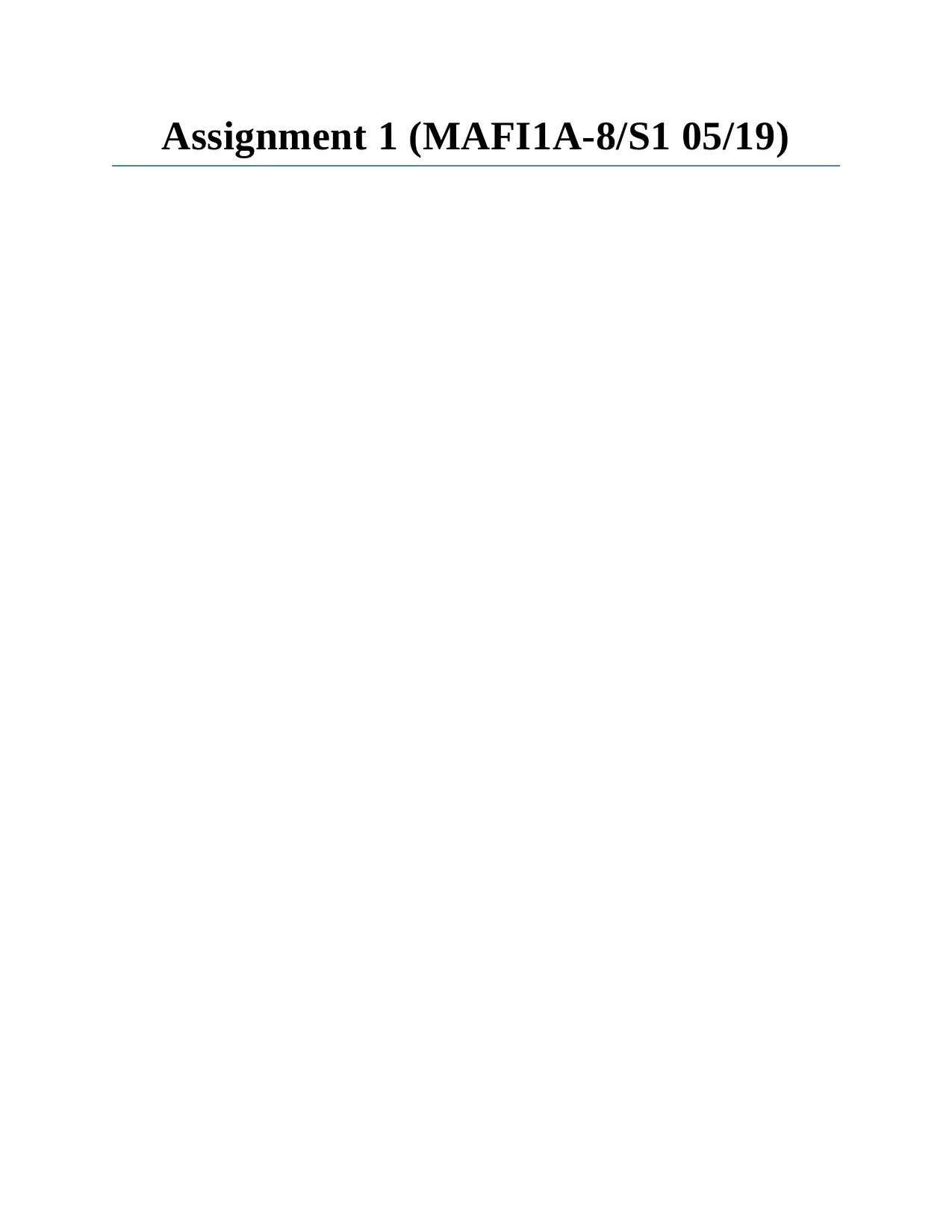
Assignment 1 (MAFI1A-8/S1 05/19)
Paraphrase This Document
Need a fresh take? Get an instant paraphrase of this document with our AI Paraphraser
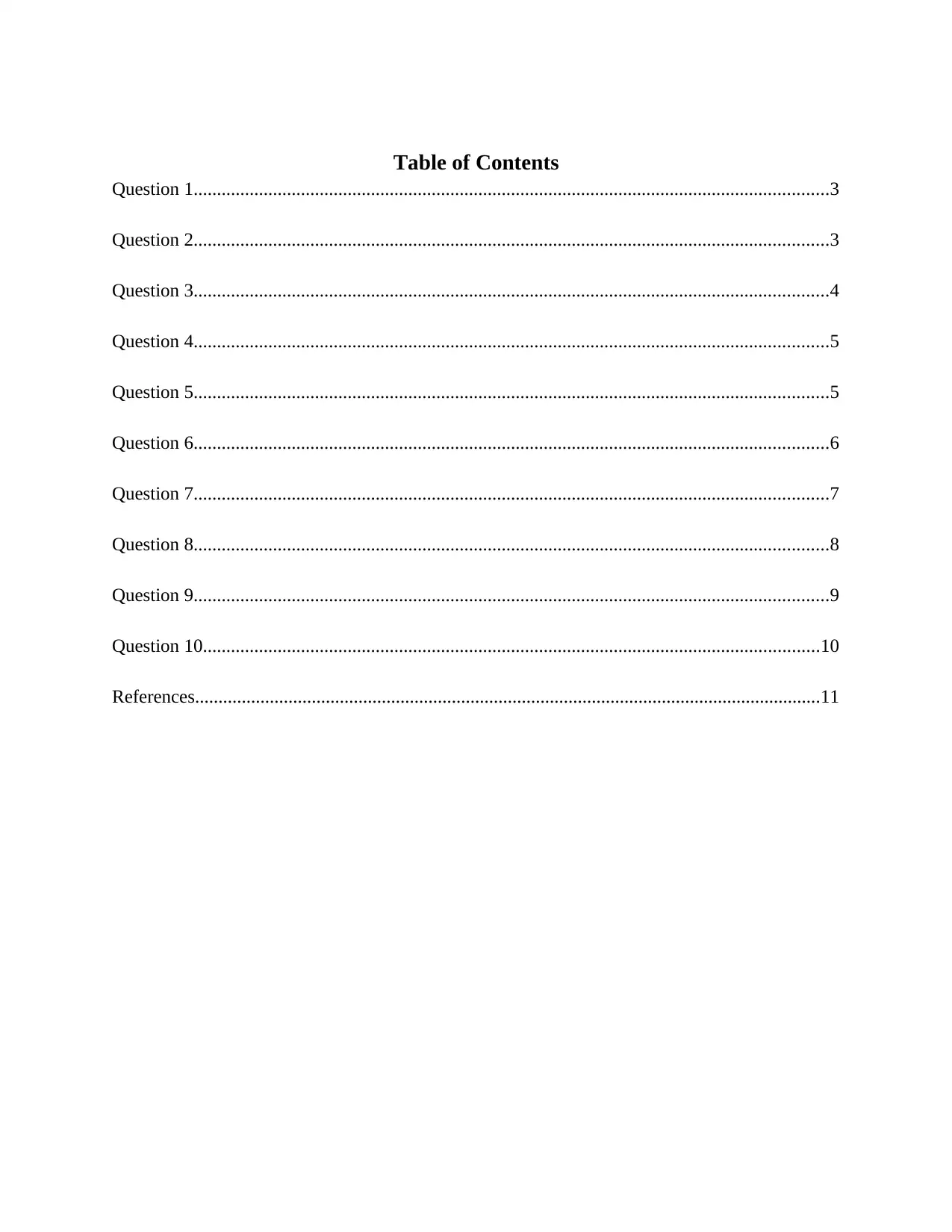
Table of Contents
Question 1........................................................................................................................................3
Question 2........................................................................................................................................3
Question 3........................................................................................................................................4
Question 4........................................................................................................................................5
Question 5........................................................................................................................................5
Question 6........................................................................................................................................6
Question 7........................................................................................................................................7
Question 8........................................................................................................................................8
Question 9........................................................................................................................................9
Question 10....................................................................................................................................10
References......................................................................................................................................11
Question 1........................................................................................................................................3
Question 2........................................................................................................................................3
Question 3........................................................................................................................................4
Question 4........................................................................................................................................5
Question 5........................................................................................................................................5
Question 6........................................................................................................................................6
Question 7........................................................................................................................................7
Question 8........................................................................................................................................8
Question 9........................................................................................................................................9
Question 10....................................................................................................................................10
References......................................................................................................................................11

QUESTION 1
If the revenue of the company is more than expenditure, then opening of store on the Sunday is
financially viable. Computation for Incremental profit/loss for the C & T, is as follows –
Table 1 Computation of Incremental Profit (Loss) on Sunday
Particulars Amount
Incremental Sales on Sunday 50*120000*150% 9000000
Gross Margin 9000000*45% 4050000
Salary to Sales Assistants on Sundays 5*50*6*180 270000
Manager's Commission Incremental Sales*2% 180000
Cost of Light 400*6*50 120000
Cost of Heat (25*6*750)+(25*8*750) 262500
Incremental Profit 3217500
QUESTION 2
Elements of Motivation
At the work place, employee motivation is one of the more crucial factor, as it affects the
performance of departments individually as well as of whole company. Employee motivation
plays significant role because it permits to management to achieve the objective of company. In
the absence of motivated workplace, company may face risky position (Barrick et al. 2015).
Motivated employees can assist towards for enhanced productivity and by which company can
achieve higher results. There are several aspects, which can be used by the company for
motivation of the employees. With regards to it, excellent communication with employees,
If the revenue of the company is more than expenditure, then opening of store on the Sunday is
financially viable. Computation for Incremental profit/loss for the C & T, is as follows –
Table 1 Computation of Incremental Profit (Loss) on Sunday
Particulars Amount
Incremental Sales on Sunday 50*120000*150% 9000000
Gross Margin 9000000*45% 4050000
Salary to Sales Assistants on Sundays 5*50*6*180 270000
Manager's Commission Incremental Sales*2% 180000
Cost of Light 400*6*50 120000
Cost of Heat (25*6*750)+(25*8*750) 262500
Incremental Profit 3217500
QUESTION 2
Elements of Motivation
At the work place, employee motivation is one of the more crucial factor, as it affects the
performance of departments individually as well as of whole company. Employee motivation
plays significant role because it permits to management to achieve the objective of company. In
the absence of motivated workplace, company may face risky position (Barrick et al. 2015).
Motivated employees can assist towards for enhanced productivity and by which company can
achieve higher results. There are several aspects, which can be used by the company for
motivation of the employees. With regards to it, excellent communication with employees,
⊘ This is a preview!⊘
Do you want full access?
Subscribe today to unlock all pages.

Trusted by 1+ million students worldwide
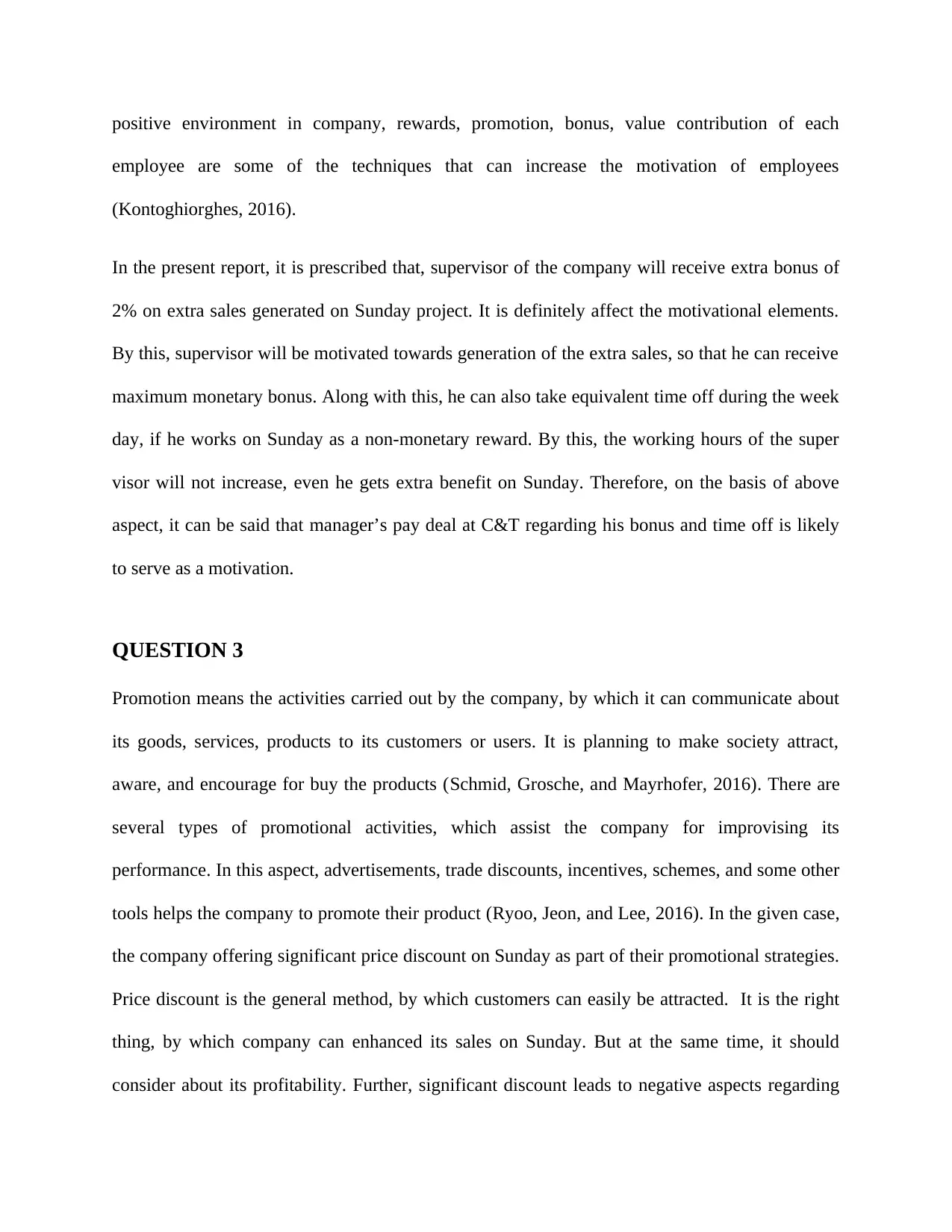
positive environment in company, rewards, promotion, bonus, value contribution of each
employee are some of the techniques that can increase the motivation of employees
(Kontoghiorghes, 2016).
In the present report, it is prescribed that, supervisor of the company will receive extra bonus of
2% on extra sales generated on Sunday project. It is definitely affect the motivational elements.
By this, supervisor will be motivated towards generation of the extra sales, so that he can receive
maximum monetary bonus. Along with this, he can also take equivalent time off during the week
day, if he works on Sunday as a non-monetary reward. By this, the working hours of the super
visor will not increase, even he gets extra benefit on Sunday. Therefore, on the basis of above
aspect, it can be said that manager’s pay deal at C&T regarding his bonus and time off is likely
to serve as a motivation.
QUESTION 3
Promotion means the activities carried out by the company, by which it can communicate about
its goods, services, products to its customers or users. It is planning to make society attract,
aware, and encourage for buy the products (Schmid, Grosche, and Mayrhofer, 2016). There are
several types of promotional activities, which assist the company for improvising its
performance. In this aspect, advertisements, trade discounts, incentives, schemes, and some other
tools helps the company to promote their product (Ryoo, Jeon, and Lee, 2016). In the given case,
the company offering significant price discount on Sunday as part of their promotional strategies.
Price discount is the general method, by which customers can easily be attracted. It is the right
thing, by which company can enhanced its sales on Sunday. But at the same time, it should
consider about its profitability. Further, significant discount leads to negative aspects regarding
employee are some of the techniques that can increase the motivation of employees
(Kontoghiorghes, 2016).
In the present report, it is prescribed that, supervisor of the company will receive extra bonus of
2% on extra sales generated on Sunday project. It is definitely affect the motivational elements.
By this, supervisor will be motivated towards generation of the extra sales, so that he can receive
maximum monetary bonus. Along with this, he can also take equivalent time off during the week
day, if he works on Sunday as a non-monetary reward. By this, the working hours of the super
visor will not increase, even he gets extra benefit on Sunday. Therefore, on the basis of above
aspect, it can be said that manager’s pay deal at C&T regarding his bonus and time off is likely
to serve as a motivation.
QUESTION 3
Promotion means the activities carried out by the company, by which it can communicate about
its goods, services, products to its customers or users. It is planning to make society attract,
aware, and encourage for buy the products (Schmid, Grosche, and Mayrhofer, 2016). There are
several types of promotional activities, which assist the company for improvising its
performance. In this aspect, advertisements, trade discounts, incentives, schemes, and some other
tools helps the company to promote their product (Ryoo, Jeon, and Lee, 2016). In the given case,
the company offering significant price discount on Sunday as part of their promotional strategies.
Price discount is the general method, by which customers can easily be attracted. It is the right
thing, by which company can enhanced its sales on Sunday. But at the same time, it should
consider about its profitability. Further, significant discount leads to negative aspects regarding
Paraphrase This Document
Need a fresh take? Get an instant paraphrase of this document with our AI Paraphraser
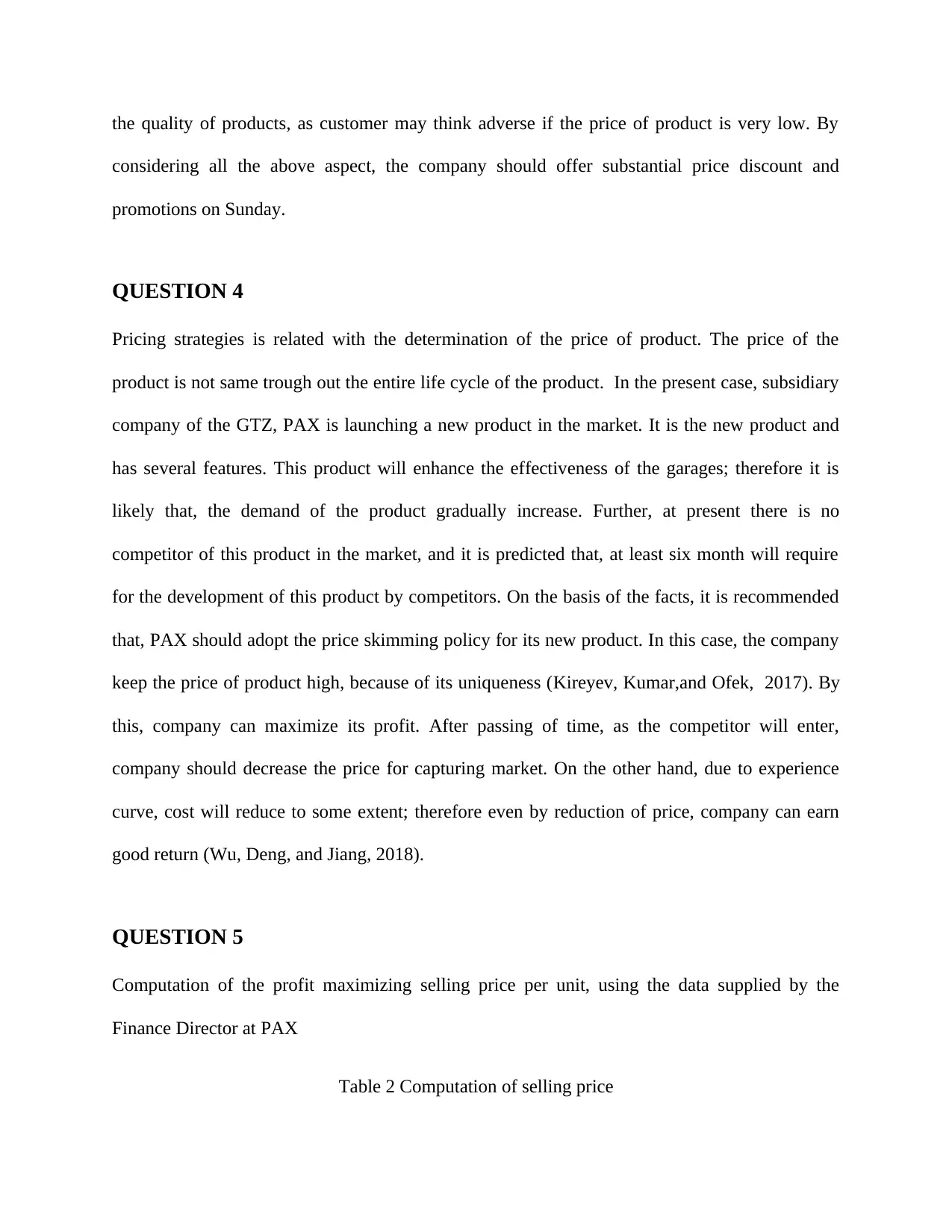
the quality of products, as customer may think adverse if the price of product is very low. By
considering all the above aspect, the company should offer substantial price discount and
promotions on Sunday.
QUESTION 4
Pricing strategies is related with the determination of the price of product. The price of the
product is not same trough out the entire life cycle of the product. In the present case, subsidiary
company of the GTZ, PAX is launching a new product in the market. It is the new product and
has several features. This product will enhance the effectiveness of the garages; therefore it is
likely that, the demand of the product gradually increase. Further, at present there is no
competitor of this product in the market, and it is predicted that, at least six month will require
for the development of this product by competitors. On the basis of the facts, it is recommended
that, PAX should adopt the price skimming policy for its new product. In this case, the company
keep the price of product high, because of its uniqueness (Kireyev, Kumar,and Ofek, 2017). By
this, company can maximize its profit. After passing of time, as the competitor will enter,
company should decrease the price for capturing market. On the other hand, due to experience
curve, cost will reduce to some extent; therefore even by reduction of price, company can earn
good return (Wu, Deng, and Jiang, 2018).
QUESTION 5
Computation of the profit maximizing selling price per unit, using the data supplied by the
Finance Director at PAX
Table 2 Computation of selling price
considering all the above aspect, the company should offer substantial price discount and
promotions on Sunday.
QUESTION 4
Pricing strategies is related with the determination of the price of product. The price of the
product is not same trough out the entire life cycle of the product. In the present case, subsidiary
company of the GTZ, PAX is launching a new product in the market. It is the new product and
has several features. This product will enhance the effectiveness of the garages; therefore it is
likely that, the demand of the product gradually increase. Further, at present there is no
competitor of this product in the market, and it is predicted that, at least six month will require
for the development of this product by competitors. On the basis of the facts, it is recommended
that, PAX should adopt the price skimming policy for its new product. In this case, the company
keep the price of product high, because of its uniqueness (Kireyev, Kumar,and Ofek, 2017). By
this, company can maximize its profit. After passing of time, as the competitor will enter,
company should decrease the price for capturing market. On the other hand, due to experience
curve, cost will reduce to some extent; therefore even by reduction of price, company can earn
good return (Wu, Deng, and Jiang, 2018).
QUESTION 5
Computation of the profit maximizing selling price per unit, using the data supplied by the
Finance Director at PAX
Table 2 Computation of selling price
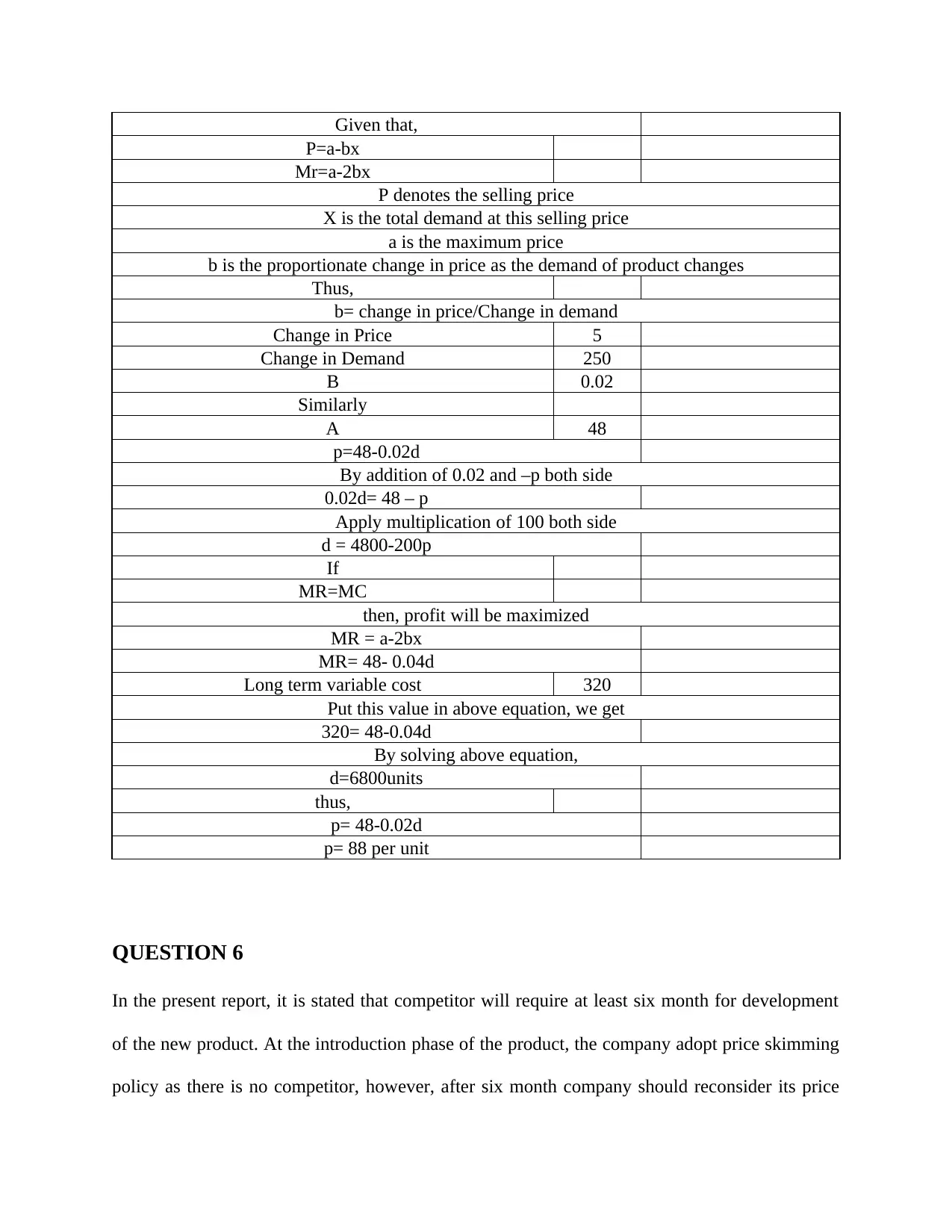
Given that,
P=a-bx
Mr=a-2bx
P denotes the selling price
X is the total demand at this selling price
a is the maximum price
b is the proportionate change in price as the demand of product changes
Thus,
b= change in price/Change in demand
Change in Price 5
Change in Demand 250
B 0.02
Similarly
A 48
p=48-0.02d
By addition of 0.02 and –p both side
0.02d= 48 – p
Apply multiplication of 100 both side
d = 4800-200p
If
MR=MC
then, profit will be maximized
MR = a-2bx
MR= 48- 0.04d
Long term variable cost 320
Put this value in above equation, we get
320= 48-0.04d
By solving above equation,
d=6800units
thus,
p= 48-0.02d
p= 88 per unit
QUESTION 6
In the present report, it is stated that competitor will require at least six month for development
of the new product. At the introduction phase of the product, the company adopt price skimming
policy as there is no competitor, however, after six month company should reconsider its price
P=a-bx
Mr=a-2bx
P denotes the selling price
X is the total demand at this selling price
a is the maximum price
b is the proportionate change in price as the demand of product changes
Thus,
b= change in price/Change in demand
Change in Price 5
Change in Demand 250
B 0.02
Similarly
A 48
p=48-0.02d
By addition of 0.02 and –p both side
0.02d= 48 – p
Apply multiplication of 100 both side
d = 4800-200p
If
MR=MC
then, profit will be maximized
MR = a-2bx
MR= 48- 0.04d
Long term variable cost 320
Put this value in above equation, we get
320= 48-0.04d
By solving above equation,
d=6800units
thus,
p= 48-0.02d
p= 88 per unit
QUESTION 6
In the present report, it is stated that competitor will require at least six month for development
of the new product. At the introduction phase of the product, the company adopt price skimming
policy as there is no competitor, however, after six month company should reconsider its price
⊘ This is a preview!⊘
Do you want full access?
Subscribe today to unlock all pages.

Trusted by 1+ million students worldwide
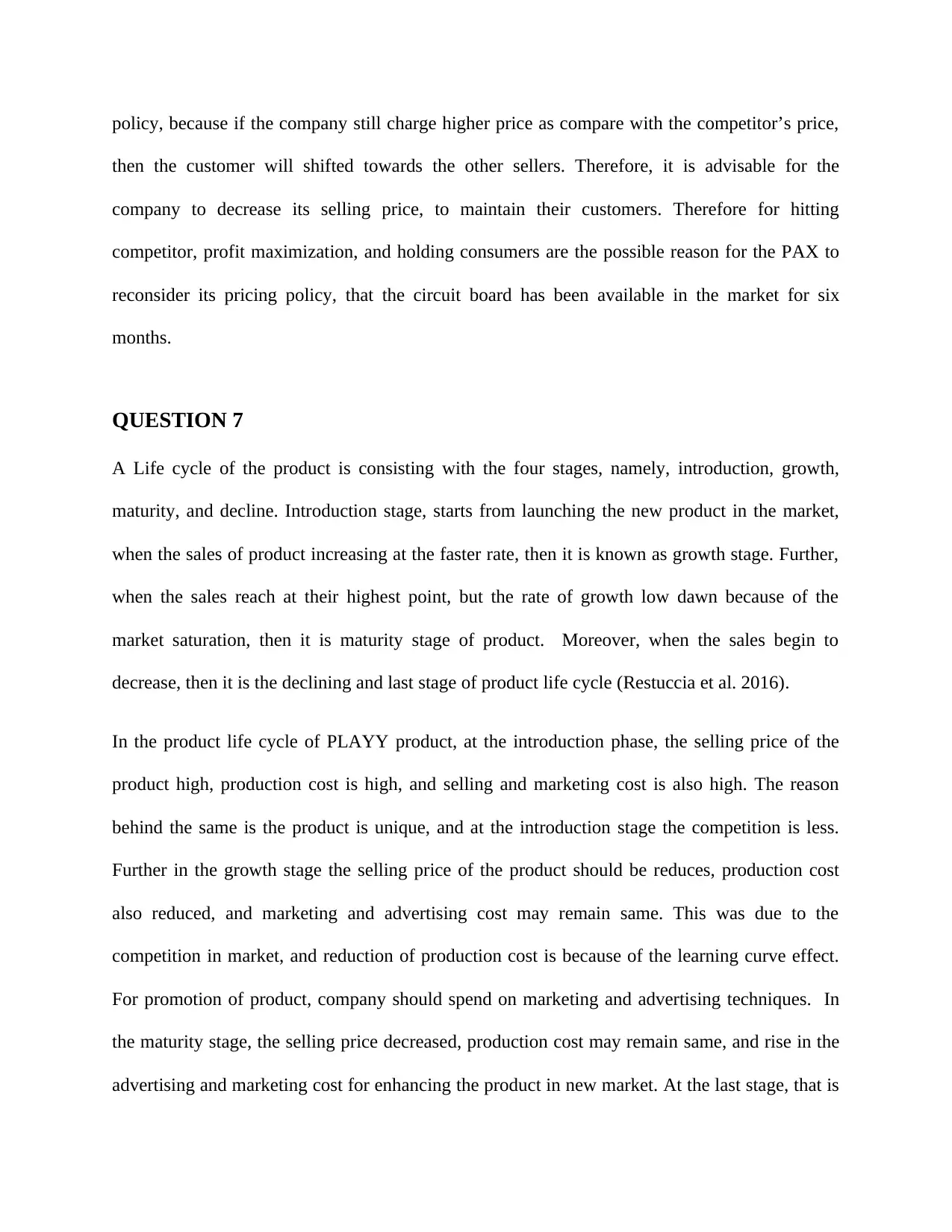
policy, because if the company still charge higher price as compare with the competitor’s price,
then the customer will shifted towards the other sellers. Therefore, it is advisable for the
company to decrease its selling price, to maintain their customers. Therefore for hitting
competitor, profit maximization, and holding consumers are the possible reason for the PAX to
reconsider its pricing policy, that the circuit board has been available in the market for six
months.
QUESTION 7
A Life cycle of the product is consisting with the four stages, namely, introduction, growth,
maturity, and decline. Introduction stage, starts from launching the new product in the market,
when the sales of product increasing at the faster rate, then it is known as growth stage. Further,
when the sales reach at their highest point, but the rate of growth low dawn because of the
market saturation, then it is maturity stage of product. Moreover, when the sales begin to
decrease, then it is the declining and last stage of product life cycle (Restuccia et al. 2016).
In the product life cycle of PLAYY product, at the introduction phase, the selling price of the
product high, production cost is high, and selling and marketing cost is also high. The reason
behind the same is the product is unique, and at the introduction stage the competition is less.
Further in the growth stage the selling price of the product should be reduces, production cost
also reduced, and marketing and advertising cost may remain same. This was due to the
competition in market, and reduction of production cost is because of the learning curve effect.
For promotion of product, company should spend on marketing and advertising techniques. In
the maturity stage, the selling price decreased, production cost may remain same, and rise in the
advertising and marketing cost for enhancing the product in new market. At the last stage, that is
then the customer will shifted towards the other sellers. Therefore, it is advisable for the
company to decrease its selling price, to maintain their customers. Therefore for hitting
competitor, profit maximization, and holding consumers are the possible reason for the PAX to
reconsider its pricing policy, that the circuit board has been available in the market for six
months.
QUESTION 7
A Life cycle of the product is consisting with the four stages, namely, introduction, growth,
maturity, and decline. Introduction stage, starts from launching the new product in the market,
when the sales of product increasing at the faster rate, then it is known as growth stage. Further,
when the sales reach at their highest point, but the rate of growth low dawn because of the
market saturation, then it is maturity stage of product. Moreover, when the sales begin to
decrease, then it is the declining and last stage of product life cycle (Restuccia et al. 2016).
In the product life cycle of PLAYY product, at the introduction phase, the selling price of the
product high, production cost is high, and selling and marketing cost is also high. The reason
behind the same is the product is unique, and at the introduction stage the competition is less.
Further in the growth stage the selling price of the product should be reduces, production cost
also reduced, and marketing and advertising cost may remain same. This was due to the
competition in market, and reduction of production cost is because of the learning curve effect.
For promotion of product, company should spend on marketing and advertising techniques. In
the maturity stage, the selling price decreased, production cost may remain same, and rise in the
advertising and marketing cost for enhancing the product in new market. At the last stage, that is
Paraphrase This Document
Need a fresh take? Get an instant paraphrase of this document with our AI Paraphraser
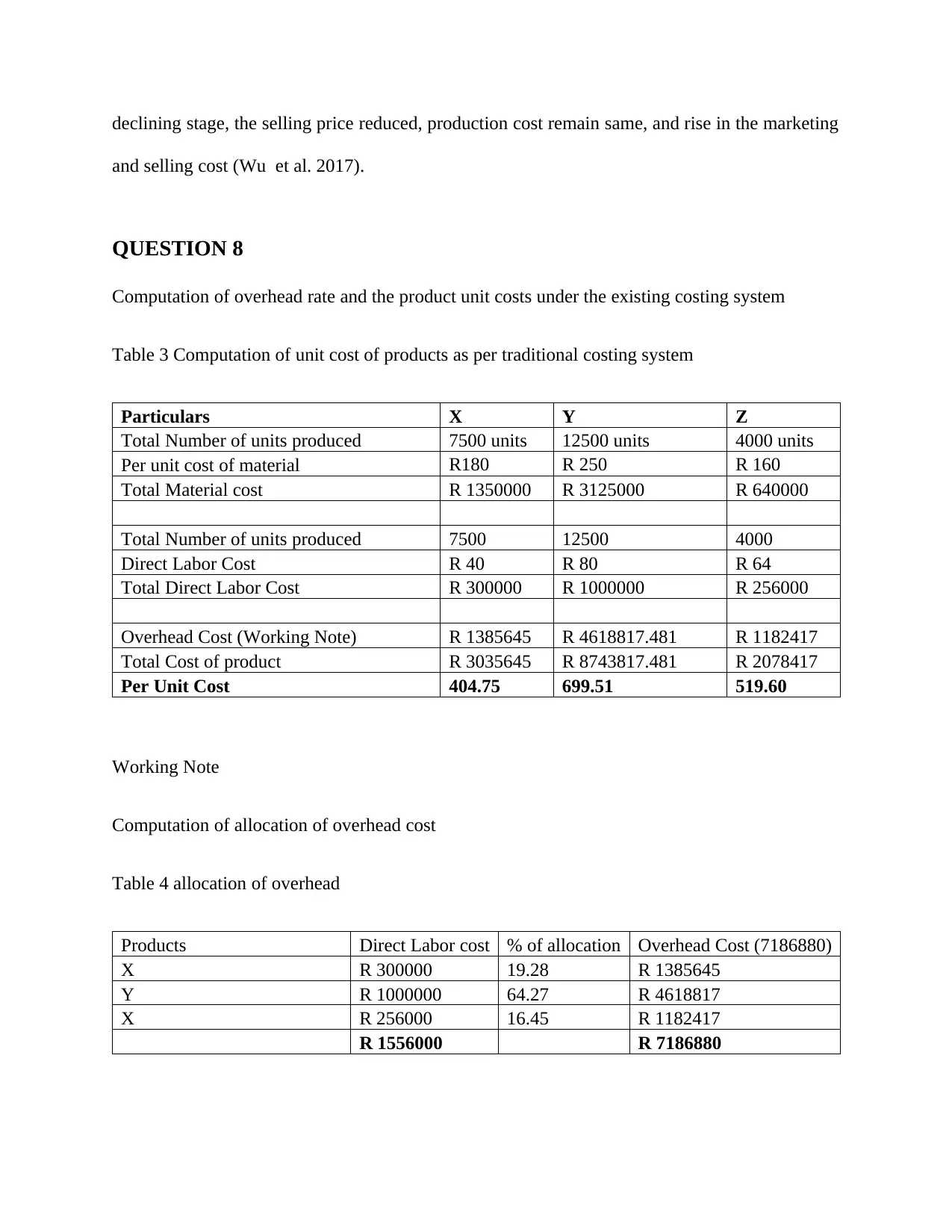
declining stage, the selling price reduced, production cost remain same, and rise in the marketing
and selling cost (Wu et al. 2017).
QUESTION 8
Computation of overhead rate and the product unit costs under the existing costing system
Table 3 Computation of unit cost of products as per traditional costing system
Particulars X Y Z
Total Number of units produced 7500 units 12500 units 4000 units
Per unit cost of material R180 R 250 R 160
Total Material cost R 1350000 R 3125000 R 640000
Total Number of units produced 7500 12500 4000
Direct Labor Cost R 40 R 80 R 64
Total Direct Labor Cost R 300000 R 1000000 R 256000
Overhead Cost (Working Note) R 1385645 R 4618817.481 R 1182417
Total Cost of product R 3035645 R 8743817.481 R 2078417
Per Unit Cost 404.75 699.51 519.60
Working Note
Computation of allocation of overhead cost
Table 4 allocation of overhead
Products Direct Labor cost % of allocation Overhead Cost (7186880)
X R 300000 19.28 R 1385645
Y R 1000000 64.27 R 4618817
X R 256000 16.45 R 1182417
R 1556000 R 7186880
and selling cost (Wu et al. 2017).
QUESTION 8
Computation of overhead rate and the product unit costs under the existing costing system
Table 3 Computation of unit cost of products as per traditional costing system
Particulars X Y Z
Total Number of units produced 7500 units 12500 units 4000 units
Per unit cost of material R180 R 250 R 160
Total Material cost R 1350000 R 3125000 R 640000
Total Number of units produced 7500 12500 4000
Direct Labor Cost R 40 R 80 R 64
Total Direct Labor Cost R 300000 R 1000000 R 256000
Overhead Cost (Working Note) R 1385645 R 4618817.481 R 1182417
Total Cost of product R 3035645 R 8743817.481 R 2078417
Per Unit Cost 404.75 699.51 519.60
Working Note
Computation of allocation of overhead cost
Table 4 allocation of overhead
Products Direct Labor cost % of allocation Overhead Cost (7186880)
X R 300000 19.28 R 1385645
Y R 1000000 64.27 R 4618817
X R 256000 16.45 R 1182417
R 1556000 R 7186880
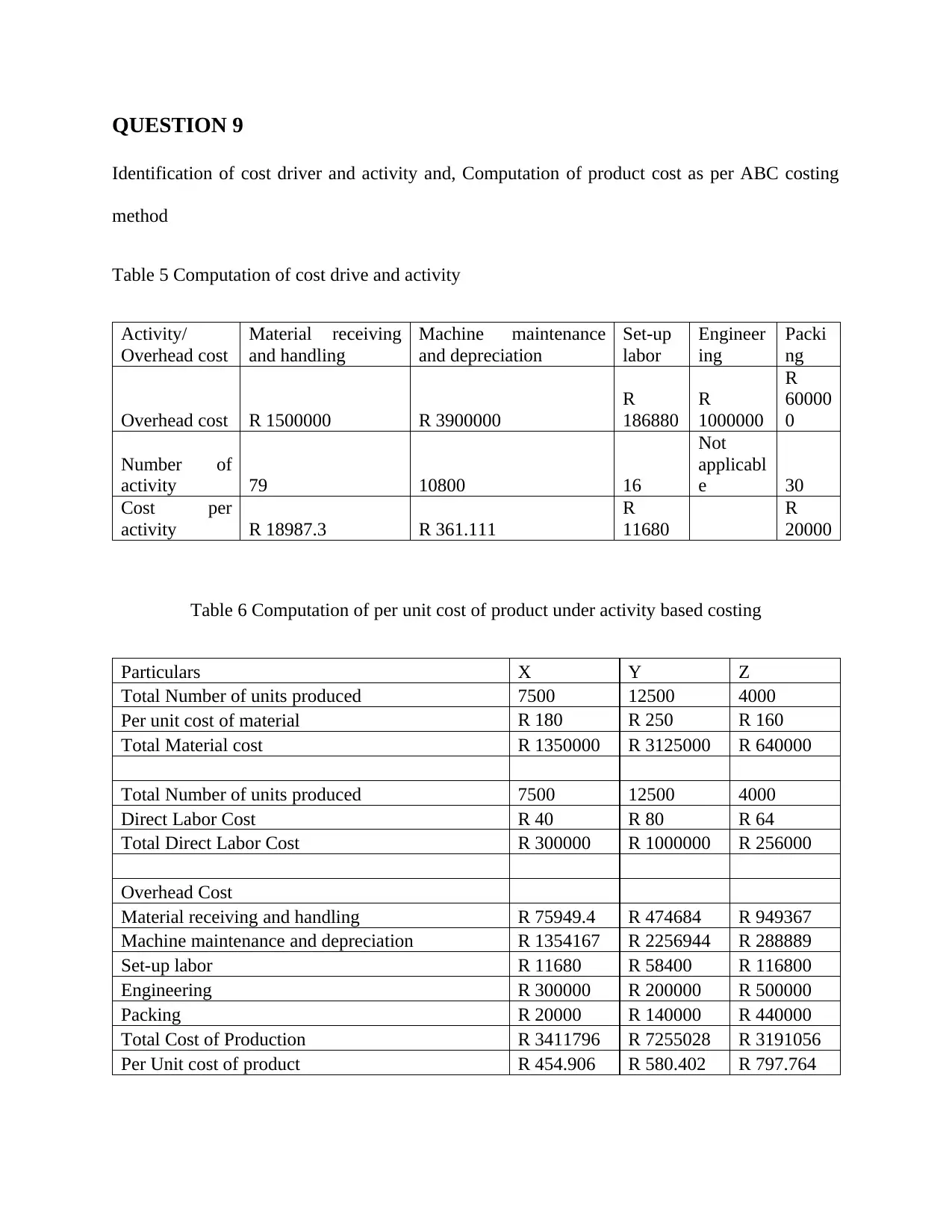
QUESTION 9
Identification of cost driver and activity and, Computation of product cost as per ABC costing
method
Table 5 Computation of cost drive and activity
Activity/
Overhead cost
Material receiving
and handling
Machine maintenance
and depreciation
Set-up
labor
Engineer
ing
Packi
ng
Overhead cost R 1500000 R 3900000
R
186880
R
1000000
R
60000
0
Number of
activity 79 10800 16
Not
applicabl
e 30
Cost per
activity R 18987.3 R 361.111
R
11680
R
20000
Table 6 Computation of per unit cost of product under activity based costing
Particulars X Y Z
Total Number of units produced 7500 12500 4000
Per unit cost of material R 180 R 250 R 160
Total Material cost R 1350000 R 3125000 R 640000
Total Number of units produced 7500 12500 4000
Direct Labor Cost R 40 R 80 R 64
Total Direct Labor Cost R 300000 R 1000000 R 256000
Overhead Cost
Material receiving and handling R 75949.4 R 474684 R 949367
Machine maintenance and depreciation R 1354167 R 2256944 R 288889
Set-up labor R 11680 R 58400 R 116800
Engineering R 300000 R 200000 R 500000
Packing R 20000 R 140000 R 440000
Total Cost of Production R 3411796 R 7255028 R 3191056
Per Unit cost of product R 454.906 R 580.402 R 797.764
Identification of cost driver and activity and, Computation of product cost as per ABC costing
method
Table 5 Computation of cost drive and activity
Activity/
Overhead cost
Material receiving
and handling
Machine maintenance
and depreciation
Set-up
labor
Engineer
ing
Packi
ng
Overhead cost R 1500000 R 3900000
R
186880
R
1000000
R
60000
0
Number of
activity 79 10800 16
Not
applicabl
e 30
Cost per
activity R 18987.3 R 361.111
R
11680
R
20000
Table 6 Computation of per unit cost of product under activity based costing
Particulars X Y Z
Total Number of units produced 7500 12500 4000
Per unit cost of material R 180 R 250 R 160
Total Material cost R 1350000 R 3125000 R 640000
Total Number of units produced 7500 12500 4000
Direct Labor Cost R 40 R 80 R 64
Total Direct Labor Cost R 300000 R 1000000 R 256000
Overhead Cost
Material receiving and handling R 75949.4 R 474684 R 949367
Machine maintenance and depreciation R 1354167 R 2256944 R 288889
Set-up labor R 11680 R 58400 R 116800
Engineering R 300000 R 200000 R 500000
Packing R 20000 R 140000 R 440000
Total Cost of Production R 3411796 R 7255028 R 3191056
Per Unit cost of product R 454.906 R 580.402 R 797.764
⊘ This is a preview!⊘
Do you want full access?
Subscribe today to unlock all pages.

Trusted by 1+ million students worldwide
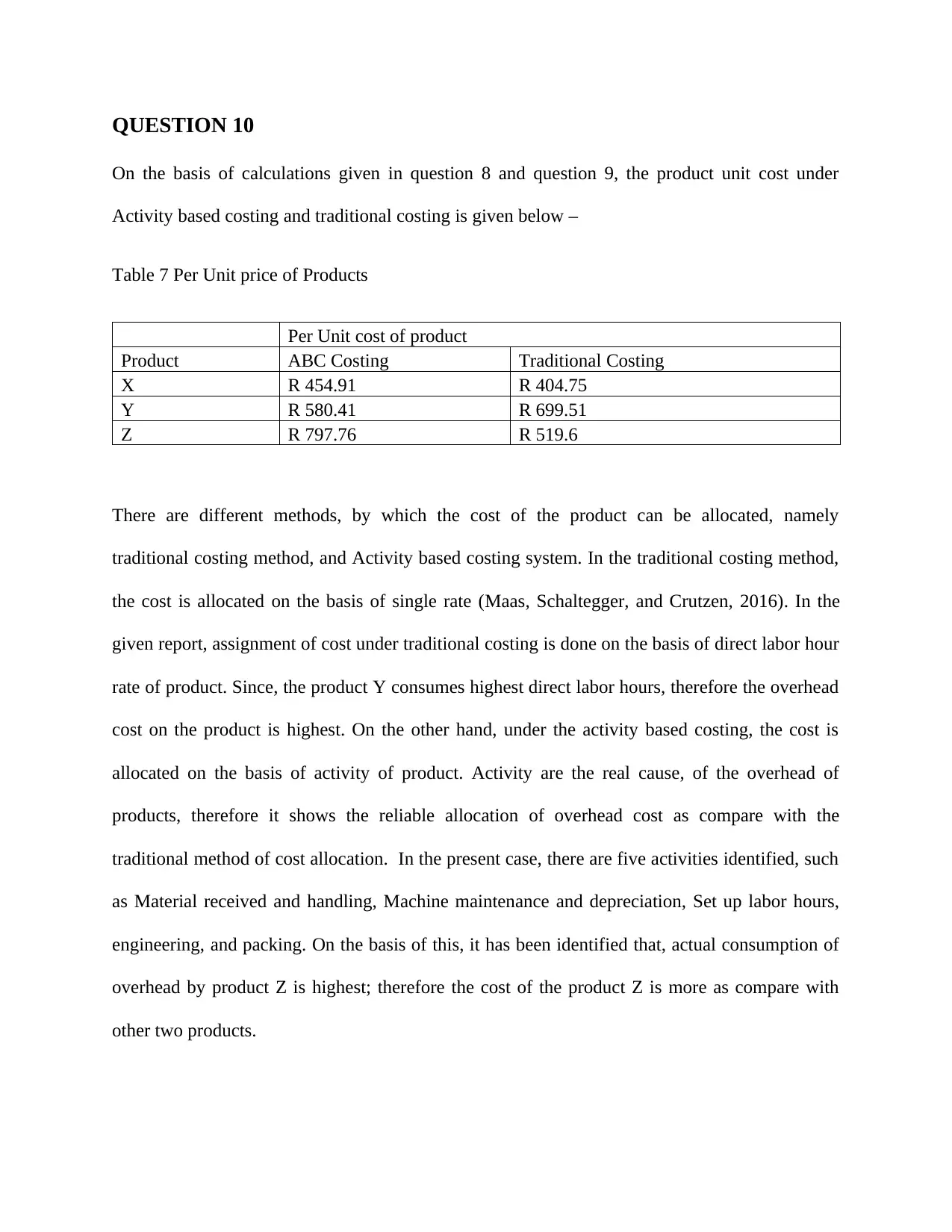
QUESTION 10
On the basis of calculations given in question 8 and question 9, the product unit cost under
Activity based costing and traditional costing is given below –
Table 7 Per Unit price of Products
Per Unit cost of product
Product ABC Costing Traditional Costing
X R 454.91 R 404.75
Y R 580.41 R 699.51
Z R 797.76 R 519.6
There are different methods, by which the cost of the product can be allocated, namely
traditional costing method, and Activity based costing system. In the traditional costing method,
the cost is allocated on the basis of single rate (Maas, Schaltegger, and Crutzen, 2016). In the
given report, assignment of cost under traditional costing is done on the basis of direct labor hour
rate of product. Since, the product Y consumes highest direct labor hours, therefore the overhead
cost on the product is highest. On the other hand, under the activity based costing, the cost is
allocated on the basis of activity of product. Activity are the real cause, of the overhead of
products, therefore it shows the reliable allocation of overhead cost as compare with the
traditional method of cost allocation. In the present case, there are five activities identified, such
as Material received and handling, Machine maintenance and depreciation, Set up labor hours,
engineering, and packing. On the basis of this, it has been identified that, actual consumption of
overhead by product Z is highest; therefore the cost of the product Z is more as compare with
other two products.
On the basis of calculations given in question 8 and question 9, the product unit cost under
Activity based costing and traditional costing is given below –
Table 7 Per Unit price of Products
Per Unit cost of product
Product ABC Costing Traditional Costing
X R 454.91 R 404.75
Y R 580.41 R 699.51
Z R 797.76 R 519.6
There are different methods, by which the cost of the product can be allocated, namely
traditional costing method, and Activity based costing system. In the traditional costing method,
the cost is allocated on the basis of single rate (Maas, Schaltegger, and Crutzen, 2016). In the
given report, assignment of cost under traditional costing is done on the basis of direct labor hour
rate of product. Since, the product Y consumes highest direct labor hours, therefore the overhead
cost on the product is highest. On the other hand, under the activity based costing, the cost is
allocated on the basis of activity of product. Activity are the real cause, of the overhead of
products, therefore it shows the reliable allocation of overhead cost as compare with the
traditional method of cost allocation. In the present case, there are five activities identified, such
as Material received and handling, Machine maintenance and depreciation, Set up labor hours,
engineering, and packing. On the basis of this, it has been identified that, actual consumption of
overhead by product Z is highest; therefore the cost of the product Z is more as compare with
other two products.
Paraphrase This Document
Need a fresh take? Get an instant paraphrase of this document with our AI Paraphraser
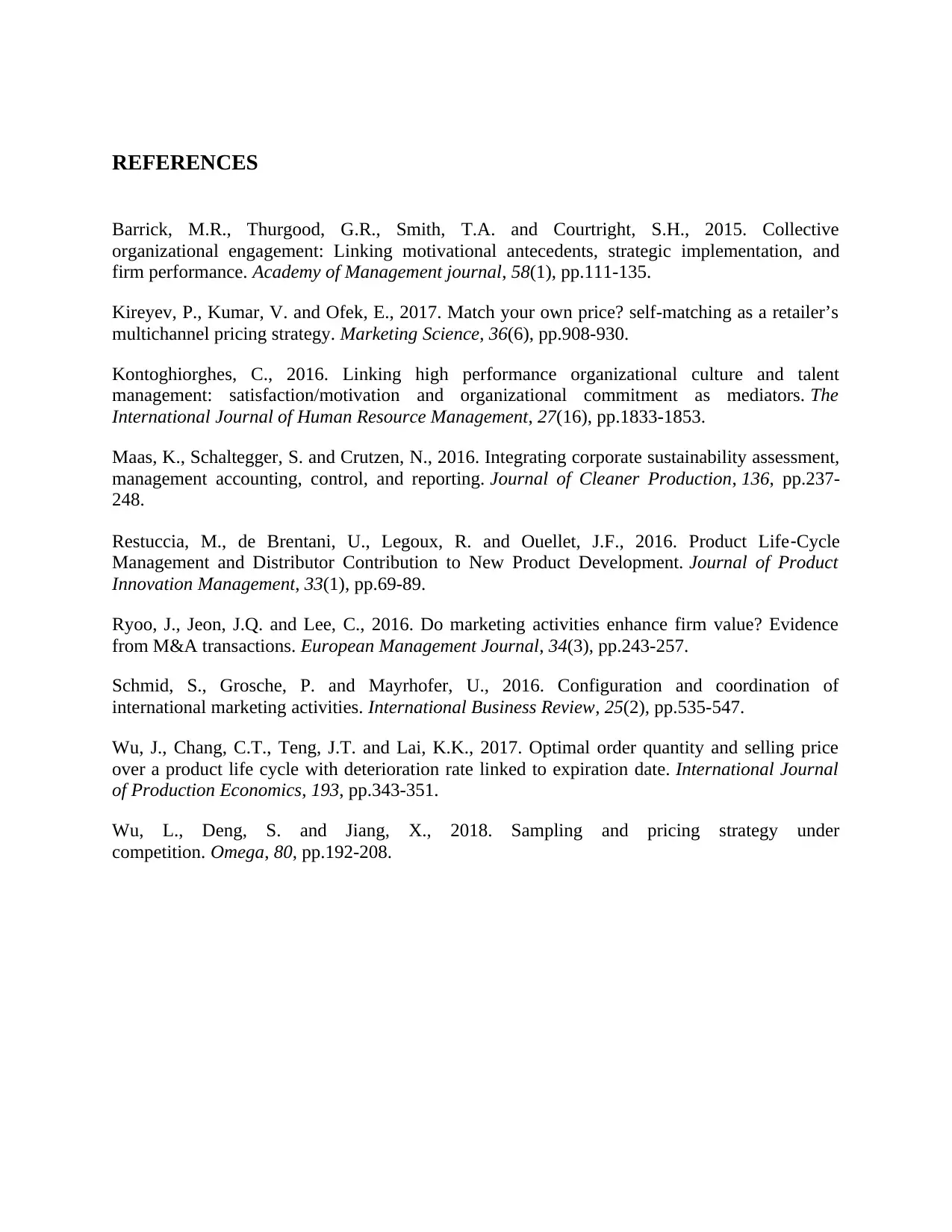
REFERENCES
Barrick, M.R., Thurgood, G.R., Smith, T.A. and Courtright, S.H., 2015. Collective
organizational engagement: Linking motivational antecedents, strategic implementation, and
firm performance. Academy of Management journal, 58(1), pp.111-135.
Kireyev, P., Kumar, V. and Ofek, E., 2017. Match your own price? self-matching as a retailer’s
multichannel pricing strategy. Marketing Science, 36(6), pp.908-930.
Kontoghiorghes, C., 2016. Linking high performance organizational culture and talent
management: satisfaction/motivation and organizational commitment as mediators. The
International Journal of Human Resource Management, 27(16), pp.1833-1853.
Maas, K., Schaltegger, S. and Crutzen, N., 2016. Integrating corporate sustainability assessment,
management accounting, control, and reporting. Journal of Cleaner Production, 136, pp.237-
248.
Restuccia, M., de Brentani, U., Legoux, R. and Ouellet, J.F., 2016. Product Life‐Cycle
Management and Distributor Contribution to New Product Development. Journal of Product
Innovation Management, 33(1), pp.69-89.
Ryoo, J., Jeon, J.Q. and Lee, C., 2016. Do marketing activities enhance firm value? Evidence
from M&A transactions. European Management Journal, 34(3), pp.243-257.
Schmid, S., Grosche, P. and Mayrhofer, U., 2016. Configuration and coordination of
international marketing activities. International Business Review, 25(2), pp.535-547.
Wu, J., Chang, C.T., Teng, J.T. and Lai, K.K., 2017. Optimal order quantity and selling price
over a product life cycle with deterioration rate linked to expiration date. International Journal
of Production Economics, 193, pp.343-351.
Wu, L., Deng, S. and Jiang, X., 2018. Sampling and pricing strategy under
competition. Omega, 80, pp.192-208.
Barrick, M.R., Thurgood, G.R., Smith, T.A. and Courtright, S.H., 2015. Collective
organizational engagement: Linking motivational antecedents, strategic implementation, and
firm performance. Academy of Management journal, 58(1), pp.111-135.
Kireyev, P., Kumar, V. and Ofek, E., 2017. Match your own price? self-matching as a retailer’s
multichannel pricing strategy. Marketing Science, 36(6), pp.908-930.
Kontoghiorghes, C., 2016. Linking high performance organizational culture and talent
management: satisfaction/motivation and organizational commitment as mediators. The
International Journal of Human Resource Management, 27(16), pp.1833-1853.
Maas, K., Schaltegger, S. and Crutzen, N., 2016. Integrating corporate sustainability assessment,
management accounting, control, and reporting. Journal of Cleaner Production, 136, pp.237-
248.
Restuccia, M., de Brentani, U., Legoux, R. and Ouellet, J.F., 2016. Product Life‐Cycle
Management and Distributor Contribution to New Product Development. Journal of Product
Innovation Management, 33(1), pp.69-89.
Ryoo, J., Jeon, J.Q. and Lee, C., 2016. Do marketing activities enhance firm value? Evidence
from M&A transactions. European Management Journal, 34(3), pp.243-257.
Schmid, S., Grosche, P. and Mayrhofer, U., 2016. Configuration and coordination of
international marketing activities. International Business Review, 25(2), pp.535-547.
Wu, J., Chang, C.T., Teng, J.T. and Lai, K.K., 2017. Optimal order quantity and selling price
over a product life cycle with deterioration rate linked to expiration date. International Journal
of Production Economics, 193, pp.343-351.
Wu, L., Deng, S. and Jiang, X., 2018. Sampling and pricing strategy under
competition. Omega, 80, pp.192-208.
1 out of 11
Related Documents
Your All-in-One AI-Powered Toolkit for Academic Success.
+13062052269
info@desklib.com
Available 24*7 on WhatsApp / Email
![[object Object]](/_next/static/media/star-bottom.7253800d.svg)
Unlock your academic potential
© 2024 | Zucol Services PVT LTD | All rights reserved.





